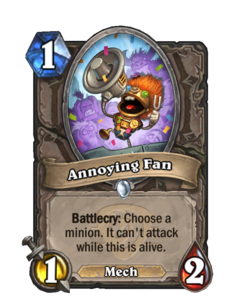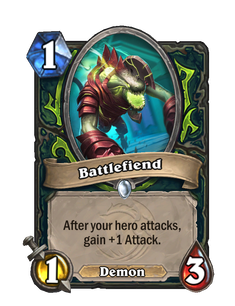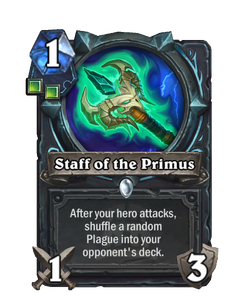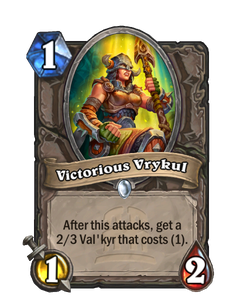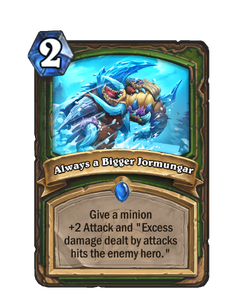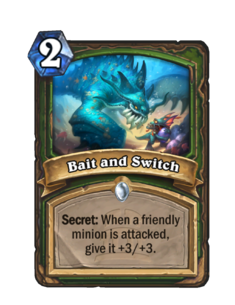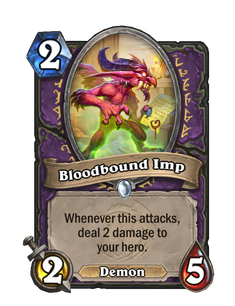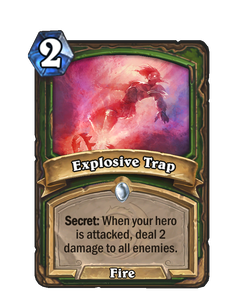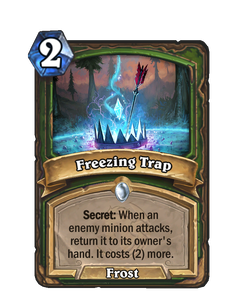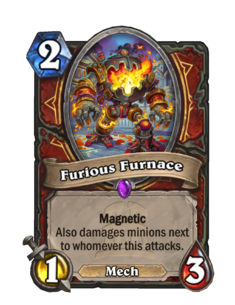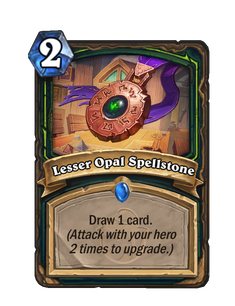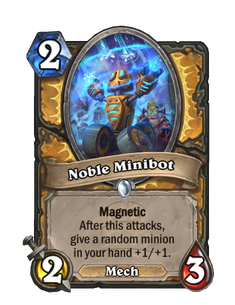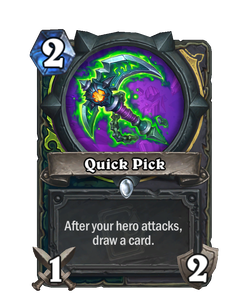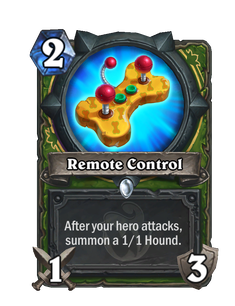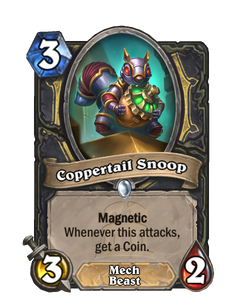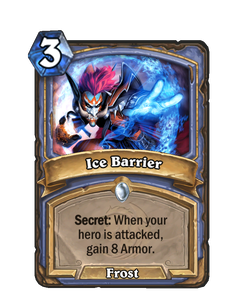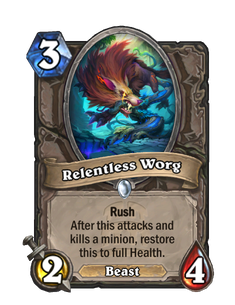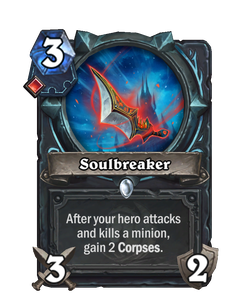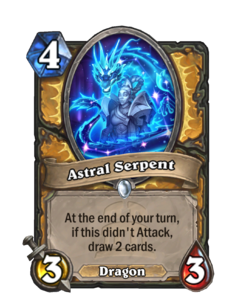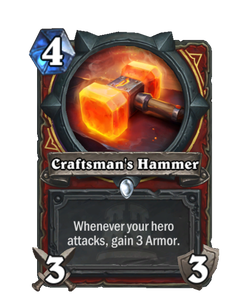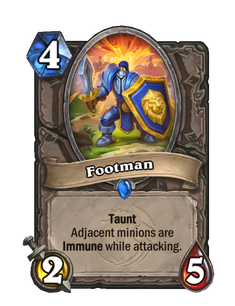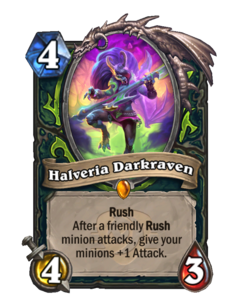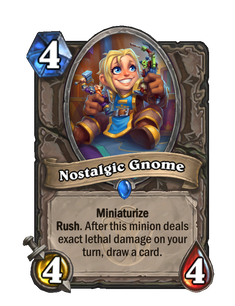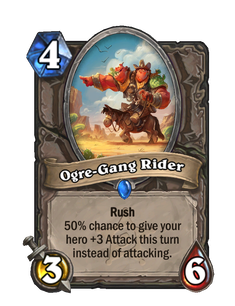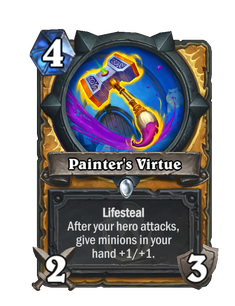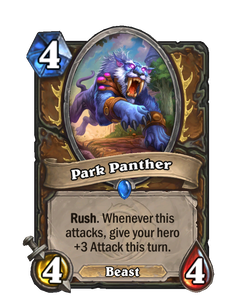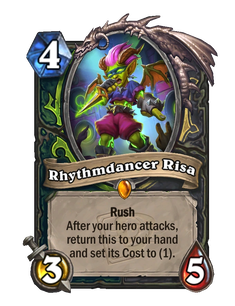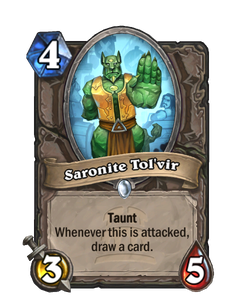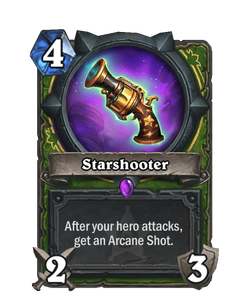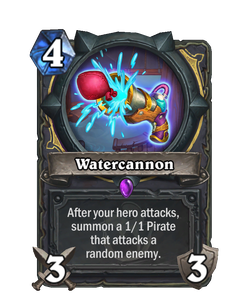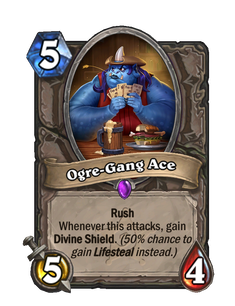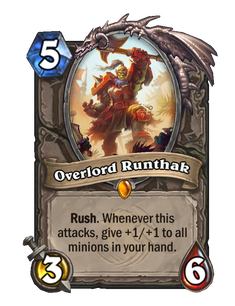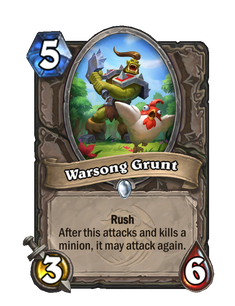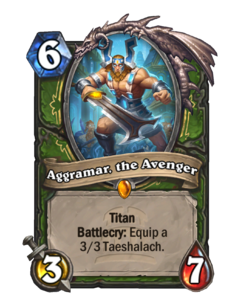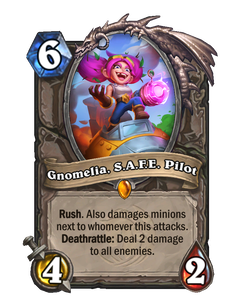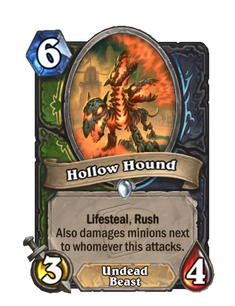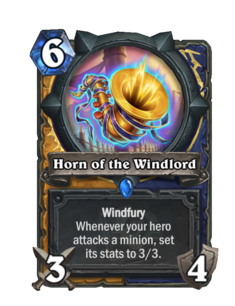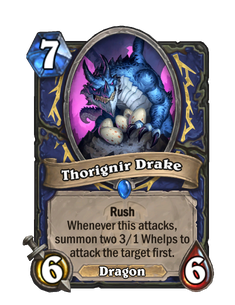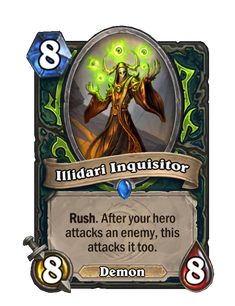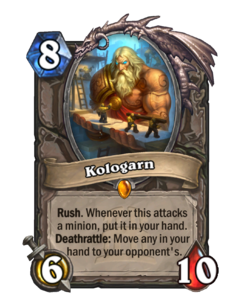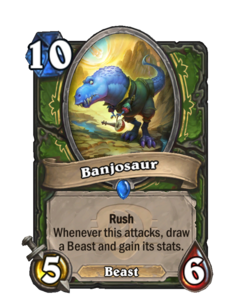Attack
- This page describes the act of attacking. For the Attack attribute, see Attribute.
Attacking or combat is what occurs when a player commands one character to attack another, causing them to simultaneously deal damage to each other. Combat is the source of the majority of the damage dealt in many Hearthstone matches, especially those involving a large number of minions. The core combat mechanics are quite simple, but the mathematics of multiple minions and heroes attacking each other can require deep strategic analysis. Attacking can also activate a variety of triggered effects, making even a single attack a potentially complex process.
Some players use "attack" to describe any damage or negative action directed toward the enemy, but in game terminology only the standard combat action described here counts as an attack and triggers related effects. Attacking in Hearthstone is usually understood to represent physical combat, particularly melee combat, in contrast to combat via spells. "Hit" and "swing" are other informal terms for attacking, as in "hit the face" or "swing into a minion".
Overview[edit | edit source]
Combat is always initiated by the attacking player, who selects the attacking character and the target of the attack. The defending player cannot respond or interfere with these choices other than through cards already played.
Each character involved in an attack deals damage equal to its Attack stat to the other. Combat is the primary way for most minions to affect the game, by attacking either the enemy hero or their minions. Minions deal their Attack damage both offensively and defensively, making them potentially dangerous on both sides of combat. Heroes can be involved in combat as either an attacker or defender too, but all sources of hero Attack power only apply on their own turn. Therefore, enemy minions can hit the hero without harm during the opponent's turn.
Weapons are also strongly associated with combat, since their primary purpose is to allow heroes to attack: the hero gains the Attack power of any equipped weapon during its own turn. Technically, a weapon does not attack an enemy, the hero using it does. When a hero using a weapon attacks, the weapon loses 1 Durability, eventually destroying it and thereby limiting its use. Heroes with weapons equipped have no option to attack without using their weapons, although they can choose not to attack at all to save weapon Durability. Weapons are the only persistent source of hero Attack, although other effects may boost a hero's Attack attribute until the end of the turn. All Attack sources are added together for a final Attack value on a hero's turn, not only that of weapons. For instance, a warrior with ![]() Fiery War Axe equipped (+3 Attack) who has cast
Fiery War Axe equipped (+3 Attack) who has cast ![]() Heroic Strike (+4 Attack) would deal 7 damage in combat that turn, not just 3 or 4.
Heroic Strike (+4 Attack) would deal 7 damage in combat that turn, not just 3 or 4.
Weapons are "sheathed" during the opponent's turn, bringing hero Attack back to zero during that time. Therefore, minions only take retaliatory weapon damage in the rare case of hitting a hero on the hero's own turn - currently only possible through ![]() Misdirection.[1]
Misdirection.[1]
Combat damage and other sources of damage use the same rules for how damage affects Health and Armor and interacts with special abilities. See Damage for more details and relevant cards.
Combat example[edit | edit source]
The basic rules of combat can be illustrated with a demonstration. Suppose a warrior's ![]() Chillwind Yeti with 4 Attack has taken 2 damage previously, leaving it with 3 remaining Health. It attacks the opposing mage's
Chillwind Yeti with 4 Attack has taken 2 damage previously, leaving it with 3 remaining Health. It attacks the opposing mage's ![]() Sen'jin Shieldmasta at full 5 Health, with 3 Attack. They simultaneously deal damage to each other: the Shieldmasta takes 4 damage from the Yeti's 4 Attack, leaving it still alive at 1 Health, while the Yeti takes 3 damage from the defending minion's 3 Attack, leaving it at 0 health and causing it to die.
Sen'jin Shieldmasta at full 5 Health, with 3 Attack. They simultaneously deal damage to each other: the Shieldmasta takes 4 damage from the Yeti's 4 Attack, leaving it still alive at 1 Health, while the Yeti takes 3 damage from the defending minion's 3 Attack, leaving it at 0 health and causing it to die.
Perhaps the warrior has 1 Health remaining, and also has 1 Armor. The warrior equips a ![]() Fiery War Axe weapon and gains 3 Attack from it, allowing him to attack. He consumes one Durability from his axe hitting the Shieldmasta, which takes 3 damage for a new Health total of -2. The Shieldmasta will die, but not before dealing its 3 damage back to the warrior, leaving the warrior at -1 Health and causing him to lose the game. The attack may have been a bad idea...or maybe the warrior had no other options and chose to go out in a blaze of glory.
Fiery War Axe weapon and gains 3 Attack from it, allowing him to attack. He consumes one Durability from his axe hitting the Shieldmasta, which takes 3 damage for a new Health total of -2. The Shieldmasta will die, but not before dealing its 3 damage back to the warrior, leaving the warrior at -1 Health and causing him to lose the game. The attack may have been a bad idea...or maybe the warrior had no other options and chose to go out in a blaze of glory.
Summary:
- Chillwind Yeti at 3 Health takes 3 damage (from 3 Attack of its enemy): 3 - 3 = 0 Health left. Sen'jin Shieldmasta at 5 Health takes 4 damage (from 4 Attack of its enemy): 5 - 4 = 1 Health left. The minions take damage simultaneously, but only the Yeti dies.
- Warrior at 1 Health, 1 Armor takes 3 damage (from 3 Attack of its enemy): 1 + 1 - 3 = -1 Health left. Shieldmasta at 1 Health takes 3 damage (from 3 Attack of its enemy): 1 - 3 = -2 Health left. The hero and minion take damage simultaneously, so the warrior loses the game as the Shieldmasta dies.
Note that this example does not contain any triggered effects, which can complicate combat immensely.
Strategy[edit | edit source]
Since minions take retaliatory damage when in combat with other minions, but not when attacking the enemy hero, a basic strategy is to kill enemy minions using one-time spells, weapons, and other removal effects whenever possible, preserving friendly minions by avoiding combat damage. The friendly minions can then hit the enemy hero over multiple turns, again avoiding combat damage to the lack of hero Attack. However, combat between minions is common as well. Depending on the deck's overall strategy, attacking can be used for board control by killing enemy minions or to aggressively attack the enemy hero, sometimes changing based on the current situation. When combat between minions is planned or expected from the enemy, players should usually look for favorable trades based on minion statistics and abilities. In same cases, particularly when an enemy Taunt minion is restricting attack options, it may be better not to attack at all.
Combat tactics are diverse, and cannot be summarized generally without knowing the specific cards, decks, or situations involved. Attack choices are a constantly changing reflection of the state of play at any time, in combination with a player's overall strategy for the game.
Attackers[edit | edit source]
The friendly character from which the attack originates is called the attacker. Normally any character with an Attack value of 1 or more can be an attacker once per turn, except for a minion's first turn in play. Characters that cannot attack due to a previous attack that turn or their first turn in play are called "exhausted". The Charge ability suppresses a minion's first-turn exhaustion, allowing it to attack immediately, but has no effect once the minion has already attacked. Windfury and Mega-Windfury allow a character to attack twice or four times in a turn, respectively, before becoming exhausted. Freeze effects can freeze a character in place, preventing it from attacking. Some minions have restrictions in their card text preventing them from attacking under specific circumstances, attacking certain targets, or attacking at all. Minions with Forgetful begin attacks normally, but may randomly change targets before finishing the attack.
Characters with 0 Attack cannot be ordered to attack. While most minions have an Attack value of at least 1, heroes by default have no Attack value. However, heroes can make attacks as well by acquiring either long-term Attack power from a weapon, or one-turn Attack from certain spells, Hero Powers, or triggered effects. Similarly, minions with 0 Attack can initiate combat if their Attack statistic is increased to a positive number by an enchantment or aura.
- Some weapons have Windfury or Forgetful, abilities that usually affect minion attacks. When such weapons are equipped, the heroes wielding them gain those effects as if they had the abilities themselves. For instance a shaman wielding
 Doomhammer can attack twice in a turn, just like any minion with Windfury.
Doomhammer can attack twice in a turn, just like any minion with Windfury. - Heroes can attack in the first turn of the game, if they have a source of Attack power. They are not exhausted like minions on their first turns.
- Minions that result from transformations suffer from first-turn exhaustion, even if the pre-transformation minion was able to attack.
- Characters that were previously unable to attack and become able to attack in the middle of a turn, such as by having their Attack stat increased above zero or having "Can't attack" silenced, may attack that turn. They do not become exhausted as if it were their first turn in play - unless it really is their first turn in play.
- A minion already on its first turn in play which gains Charge later in the turn becomes able to attack, suppressing exhaustion. However, losing the ability before attacking would restore the exhausted status. The same is true of a character that has already attacked once but gains Windfury later in the turn.[2]
- Losing and then gaining the capability to attack does not remove exhaustion if the character already attacked that turn. Losing and then gaining Windfury does not remove exhaustion if the character already attacked twice that turn.[3]
Defenders[edit | edit source]
The enemy character targeted for attack is called the defender. Normally any enemy character may be chosen by the attacking player, but Taunt prevents any character without Taunt from being targeted. Immune and Stealthed characters cannot be targeted at all.
- If there is more than one enemy Taunt on the battlefield, the player may choose which to attack.
- If all enemy Taunt minions are Immune or in Stealth, the Taunt ability is suppressed and the player may select other targets normally. For instance, if a
 Worgen Infiltrator is given Taunt by
Worgen Infiltrator is given Taunt by  Sunfury Protector while still in Stealth, the Worgen cannot be attacked due to Stealth, but the Protector or the hero may still be attacked since the Taunt ability is inactive. Once the Worgen becomes un-Stealthed, Taunt becomes active again and it must be attacked before other characters.
Sunfury Protector while still in Stealth, the Worgen cannot be attacked due to Stealth, but the Protector or the hero may still be attacked since the Taunt ability is inactive. Once the Worgen becomes un-Stealthed, Taunt becomes active again and it must be attacked before other characters. - In the rare case that no characters are available to attack, ordering an attack action is impossible, for example if the enemy warlock has a Stealthed
 Mal'Ganis making him Immune.
Mal'Ganis making him Immune.
Some triggered effects including Forgetful can redirect the attack to a different, random defender. If this happens, the combat proceeds normally using the new defender, as if the attacker had deliberately attacked it. The new defender could be one that would not normally be allowed, such as minions in Stealth or those "behind" Taunt. Forgetful-type effects will only choose enemies as new targets, but ![]() Misdirection's possible targets even include the attacker's own allies. However, a minion can never attack itself. Redirection of attacks can lead to some surprising results - read about triggered effects below for more details.
Misdirection's possible targets even include the attacker's own allies. However, a minion can never attack itself. Redirection of attacks can lead to some surprising results - read about triggered effects below for more details.
Advanced rules[edit | edit source]
Attack action[edit | edit source]
"Attack" is one of the Player Actions that a player can actively do during their turn (the others are: "Play a card", "Use a Hero Power", "End the turn" and "Concede"), and as such it starts its own Sequence.
To start an Attack (or combat) a player must choose an attacking character (the attacker) by clicking on it and select a defending character (the defender) by clicking on it.
- After clicking on a valid attacker a red arrow appears, visible to both players, going from the attacker to the player's mouse pointer. It disappears after the player clicks on the choosen valid defender.
- While
 Mayor Noggenfogger's effect is active, the red targeting arrow is replaced with a question mark.
Mayor Noggenfogger's effect is active, the red targeting arrow is replaced with a question mark. - While choosing a defender the player can cancel the action by clicking on a empty space or by right-clicking: in these cases the combat never begins and the player may choose a different action.
Choosing an attacker[edit | edit source]
Characters that are able to attack are shown by a bright green frame around their portraits. In particular:
- A character with an Attack of 0 (like
 Shieldbearer and most heroes) cannot attack.
Shieldbearer and most heroes) cannot attack. - A minion with the Can't attack ability (such as
 Ancient Watcher and
Ancient Watcher and  Ragnaros the Firelord) cannot attack. Notice that this does not include characters with the Can't attack heroes ability (such as
Ragnaros the Firelord) cannot attack. Notice that this does not include characters with the Can't attack heroes ability (such as  Icehowl or a hero equipping
Icehowl or a hero equipping  Fool's Bane), which can be normally selected as attackers but will have some restrictions while selecting a blocker.
Fool's Bane), which can be normally selected as attackers but will have some restrictions while selecting a blocker. - A character that is Frozen due to a Freeze effect cannot attack.
- When a minion enters the battlefield or changes controller it is exhausted (it is also said to have "summoning sickness"): an exhausted minion cannot attack (and has a "zzz" text floating up from the portrait), unless it has Charge.
- Heroes do not suffer from exhaustion, only minions.
- A minion with Charge can attack the same turn it enters a side of the battlefield, and the combat will not be cancelled if it loses Charge after being selected as the attacker.
- Example: If you control a
 Tundra Rhino with 2 Health, play a
Tundra Rhino with 2 Health, play a  River Crocolisk and attack with it (thanks to the temporary Charge granted by Tundra Rhino), the combat will not be cancelled if the Tundra Rhino dies before the actual combat happens to an opponent's Explosive Trap.
River Crocolisk and attack with it (thanks to the temporary Charge granted by Tundra Rhino), the combat will not be cancelled if the Tundra Rhino dies before the actual combat happens to an opponent's Explosive Trap.
- Charge is a minion ability that suppresses exhaustion, although without removing it.
- Example: If Charge is removed by Silence from a newly-summoned minion before it attacks, the minion will become exhausted and will not be able to attack that turn.
- Exhaustion is removed from a minion at the beginning of its controller's next turn.
- A character that already attacked its maximum number of times for that turn cannot attack again. A character can usually attack up to one time per turn, with the following exceptions:
- A character with Windfury (such as
 Al'Akir the Windlord or a hero equipping
Al'Akir the Windlord or a hero equipping  Doomhammer) can attack up to two times per turn, while a character with Mega-Windfury (such as
Doomhammer) can attack up to two times per turn, while a character with Mega-Windfury (such as  V-07-TR-0N) can attack up to four times each turn. Multiple instances of Windfury and/or Mega-Windfury do not stack.
V-07-TR-0N) can attack up to four times each turn. Multiple instances of Windfury and/or Mega-Windfury do not stack.
- Example: If a character gains Windfury after making its first attack, it may make a second attack that turn.
- Example: If a character loses Windfury after making the first attack but before making the second, it cannot make the second attack.
- Example: If a minion with Windfury attacks twice, loses Windfury, then gains it again, it will not be able to attack again that turn since it has already attacked twice.
- Example: If
 V-07-TR-0N is given Windfury by
V-07-TR-0N is given Windfury by  Windspeaker, it still can attack up to four times pe turn, not six.
Windspeaker, it still can attack up to four times pe turn, not six.
- A hero equipping
 Fool's Bane can attack any number of times per turn (although they are still restricted to attack minions and by weapon's Durability).
Fool's Bane can attack any number of times per turn (although they are still restricted to attack minions and by weapon's Durability).
- Example: If you attack with Fool's Bane before equipping another weapon, you can't attack with that weapon anymore that turn.
- Example: If you equip Fool's Bane after attacking with another weapon, you can still attack minions multiple times with it.
 Giant Sand Worm may attack again after it attacked and killed a minion (i.e., the defender is a minion that has been mortally wounded or set as pending destroy).
Giant Sand Worm may attack again after it attacked and killed a minion (i.e., the defender is a minion that has been mortally wounded or set as pending destroy).
- Example: A Giant Sand Worm with Windfury can attack the enemy hero, then attack an enemy minion (due to Windfury) and, if it killed it, it can attack again another minion or the enemy hero (due to its triggered effect).
- A character with Windfury (such as
Choosing a defender[edit | edit source]
An attack can target any enemy character, with the following restrinctions:
- A Stealthed minion cannot be targeted by enemy attacks.
- An Immune hero or minion cannot be targeted by enemy attacks.
- If the opponent has one or more characters with Taunt on the battlefield (shown by a shield-like border enclosing them), the player will only be able to command melee attacks at one of them.
- Trying to attack a non-Taunt target while there is an enemy Taunt minion on the battlefield will generate the error message "A minion with Taunt is in the way".
- When a minion with Taunt is Stealthed or Immune, the Taunt effect is temporarily negated (as clearly indicated by a visual effect): it will take effect only after the minion loses its Stealth and/or Immune buff.
- If the attacker has the Can't attack heroes ability (such as
 Icehowl or a hero equipping
Icehowl or a hero equipping  Fool's Bane) the enemy hero cannot be selected as the defender.
Fool's Bane) the enemy hero cannot be selected as the defender.
Combat Sequence[edit | edit source]
Then the following Combat Sequence takes place, in order: [to be continued soon]
Sequence of events and triggers[edit | edit source]
- See also: Advanced rulebook#Combat for more examples and comprehensive details.
Attacks occur in a sequence of phases and events to allow triggered effects to occur before and after the attack. For each event, triggers occur in order of play as usual. The following is a summary of these effects (as of the Whispers of the Old Gods card set) in the order they occur, along with their more common interactions.
Preparation[edit | edit source]
After the attack order is locked in, certain attack-triggered effects occur from the "proposed attack", primarily those that redirect attacks or kill or create minions. If an attack is redirected, triggers get another chance to activate based on the new defender. This can even happen multiple times with multiple redirection triggers.[4][5][6] If the attacker or defender (almost always the attacker) is mortally wounded, destroyed, or leaves play during this time, some triggers may be cancelled, although the exact conditions vary from card to card. Once this event is complete, all attack redirections will be complete, and their result will be considered the sole defender for all remaining combat steps.
- Cards that trigger from the proposed attack:
 Freezing Trap,
Freezing Trap,  Explosive Trap,
Explosive Trap,  Snake Trap,
Snake Trap,  Misdirection,
Misdirection,  Noble Sacrifice,
Noble Sacrifice,  Vaporize,
Vaporize,  Ice Barrier, Forgetful,
Ice Barrier, Forgetful,  Mogor the Ogre,
Mogor the Ogre,  Shaku, the Collector,
Shaku, the Collector,  Genzo, the Shark, and
Genzo, the Shark, and  Mayor Noggenfogger. Additionally,
Mayor Noggenfogger. Additionally,  Gladiator's Longbow's Immune effect appears to occur in play order at this time, although this may be a bug.
Gladiator's Longbow's Immune effect appears to occur in play order at this time, although this may be a bug. - Example of multiple redirection: An
 Ogre Brute attacks the enemy hero, triggering Explosive Trap, which deals 2 damage to it. It is then Misdirected to hit an enemy minion, triggering Snake Trap due to the new target. Its Forgetful ability then triggers, causing it to redirect again and hit one of the snakes. For the rest of combat, the snake is considered the sole defender of the attack.
Ogre Brute attacks the enemy hero, triggering Explosive Trap, which deals 2 damage to it. It is then Misdirected to hit an enemy minion, triggering Snake Trap due to the new target. Its Forgetful ability then triggers, causing it to redirect again and hit one of the snakes. For the rest of combat, the snake is considered the sole defender of the attack. - Example of cancelled trigger: A
 Loot Hoarder attacks the enemy hero, triggering Explosive Trap and Freezing Trap, in that order. Explosive Trap mortally wounds the Loot Hoarder, and Freezing Trap is cancelled since it requires a non-mortally wounded target in play.[7] If the Freezing Trap had triggered first, returning the Loot Hoarder to the hand, the Explosive Trap would not have been cancelled since it does not require the attacker to still be in play.[8]
Loot Hoarder attacks the enemy hero, triggering Explosive Trap and Freezing Trap, in that order. Explosive Trap mortally wounds the Loot Hoarder, and Freezing Trap is cancelled since it requires a non-mortally wounded target in play.[7] If the Freezing Trap had triggered first, returning the Loot Hoarder to the hand, the Explosive Trap would not have been cancelled since it does not require the attacker to still be in play.[8]
After the proposed attack triggers finish, other pre-attack triggered effects occur, primarily those that do not significantly affect the board. Note that the game does not process deaths resulting from the "proposed attack" before this new round of triggers, which may prevent the death entirely.
- Cards that trigger at this time:
 Cutpurse,
Cutpurse,  Truesilver Champion,
Truesilver Champion,  Power Word: Glory, and
Power Word: Glory, and  Blessing of Wisdom.
Blessing of Wisdom. - Example of pre-attack trigger preventing death from proposed attack: A paladin at 2 Health wielding Truesilver Champion attacks a Hunter with Explosive Trap. The Explosive Trap brings the paladin to 0 Health, but the Truesilver Champion subsequently heals the paladin back to 2 Health. The attack completes and the match continues.[9]
Any deaths from pre-combat triggers will be resolved at this point. If any player has lost all their Health, the game is over, without completing the attack. If the attacker or defender is no longer in play, the attack will be cancelled. If an attack is cancelled by the removal of the defender, the attacker will not be exhausted and may attempt to attack again. However, the attack will still occur if the attacker has been reduced to 0 Attack power by the loss of a friendly aura.
- Example of game ending before completion of combat: A player with 1 Health attacks a hunter with 3 Health and Explosive Trap using a
 Sen'jin Shieldmasta. The Explosive Trap kills the player, and the player loses the game instead of hitting and killing the hunter.[10]
Sen'jin Shieldmasta. The Explosive Trap kills the player, and the player loses the game instead of hitting and killing the hunter.[10] - Example of attacker leaving play, cancelling combat: A minion with 1 Health attacks a hunter with Explosive Trap. The Explosive Trap kills the attacker. The attack never finishes, so the hunter does not take damage.[11]
- Example of defender leaving play, cancelling combat: A priest wielding a Truesilver Champion attacks a minion with 1 Health. The Truesilver Champion heals the priest, triggering a pre-nerf
 Shadowboxer which kills the defender. The attack does not complete, the weapon does not lose durability, the priest can attack again, and the priest keeps the 2 Health restored![12]
Shadowboxer which kills the defender. The attack does not complete, the weapon does not lose durability, the priest can attack again, and the priest keeps the 2 Health restored![12]
Combat[edit | edit source]
The attacker and defender deal damage to each other at the same time, possibly triggering damage-related effects. Although the damage is simultaneous, any triggers from the attacker's damage occur before those for the defender.[13][14] If there are multiple triggers for the attacker's damage, they occur in order of play, and the same for the defender's damage. Additionally, any weapon used to attack loses one Durability at this point, possibly destroying the weapon.
The damage dealt by each character is equal to its Attack attribute at that moment. If the Attack value is 0 for a character, no damage will be dealt and no damage triggers will occur due to that half of the combat. Weapons and other hero Attack increases are only active during the controlling hero's turn, and therefore do not contribute to Attack power or deal defensive damage on the opponent's turn, when the hero is likely to be attacked. However, if a redirection effect causes a hero to be hit on their own turn, any Attack power from weapons or other sources will cause damage to the attacker, which is usually a friendly minion. This does not cause the weapon to lose Durability.[1]
- Example of attacker with 0 Attack: A
 Shieldbearer with 1 Attack due to an adjacent
Shieldbearer with 1 Attack due to an adjacent  Dire Wolf Alpha swings at an enemy hunter, triggering Explosive Trap, killing the Dire Wolf Alpha during combat preparation. The Shieldbearer loses its 1 Attack and deals no damage to the hunter.[15]
Dire Wolf Alpha swings at an enemy hunter, triggering Explosive Trap, killing the Dire Wolf Alpha during combat preparation. The Shieldbearer loses its 1 Attack and deals no damage to the hunter.[15] - Example of hitting the friendly hero: A
 Harvest Golem attacks the enemy hunter, triggering
Harvest Golem attacks the enemy hunter, triggering  Misdirection, resulting in the friendly warrior hero becoming the defender, who has 3 Attack from an equipped
Misdirection, resulting in the friendly warrior hero becoming the defender, who has 3 Attack from an equipped  Fiery War Axe. The Golem deals 2 damage to the friendly hero, and takes 3 damage from him due to the weapon's Attack power, killing the Golem.[16]
Fiery War Axe. The Golem deals 2 damage to the friendly hero, and takes 3 damage from him due to the weapon's Attack power, killing the Golem.[16]
Immediately after the damage exchange, a final set of attack-related triggers is resolved. Combat deaths and consequences are only handled after triggered effects complete.
- Cards that trigger after the attack:
 Bear Trap,
Bear Trap,  Magnataur Alpha,
Magnataur Alpha,  Foe Reaper 4000,
Foe Reaper 4000,  Knuckles,
Knuckles,  Finja, the Flying Star,
Finja, the Flying Star,  Lotus Illusionist,
Lotus Illusionist,  Lotus Assassin, and
Lotus Assassin, and  Wind-up Burglebot.
Wind-up Burglebot. - Cards suspected to trigger after the attack:
 Brass Knuckles and
Brass Knuckles and  Piranha Launcher.
Piranha Launcher. - Example of death caused after combat: A rogue with 1 Health attacks the enemy hunter, bringing it to 0 Health. Bear Trap activates, triggering Knife Juggler, which hits the rogue with the knife. Both heroes die, ending the match in a draw.
- Example of triggers affecting death processing: A Finja at 1 Health attacks an enemy minion with 1 Attack, reducing the enemy minion to negative Health but dropping to 0 Health itself. It triggers, putting two Murloc Warleaders onto the battlefield, thereby increasing its Health and surviving the combat.[17]
Related cards[edit | edit source]
- For Wild format listings, see Attacking/Wild format.
This section lists cards that have effects related to the act of attacking. For cards related to the Attack attribute, see Attack
References[edit | edit source]
- ↑ 1.0 1.1 Ben Brode on Twitter. (2014-11-12).
- ↑ Kripparrian (2015-06-15). Kripp's Best & Worst Arena Moments 7.
- ↑ Tested by User:Jerodast, 2015-08-08
- ↑ Zeriyah on Twitter (X). (2014-12-02).
- ↑ Ben Brode on Twitter (X). (2014-12-03).
- ↑ Zeriyah on Twitter (X). (2014-12-03).
- ↑ Patashu (2015-5-5). [Hearthstone Science] Explosive Trap, Freezing Trap, Blessing of Wisdom.
- ↑ Rai Kanegasi (2014-6-22). Freezing and Explosive Traps - Hearthstone.
- ↑ SRankGaming (2014-3-14). Cheesy Hearthstone Win - Explosive Trap?. (Warning: Strong language.)
- ↑ TehJumpingJawa (2014-1-28). Minion attack that triggers an Explosive Trap doesn't resolve if explosion kills your Hero. Intended?.
- ↑ DarkClosetOfTheMind (2014-3-20). Hearth Stone - Playing Explosive Trap.
- ↑ 정민영 (2015-2-14). Hearthstone Ultimate Combo (Truesilver Champion+Shadowboxer).
- ↑ Patashu (2015-5-17). [Hearthstone Science] Order of Damage Triggers in Combat Demonstration.
- ↑ Patashu (2015-5-17). [Hearthstone Science] Order of Damage Triggers in Combat Demonstration 2.
- ↑ Hearth (2014-5-7). How Could A Minion Deal 0 Damage to a Hero after Attacking?.
- ↑ BlizzPro (2013-10-12). Hearthstone: Misdirection vs. Hero with Weapon Equipped.
- ↑ Trolden (2017-03-17). Funny And Lucky Moments - Hearthstone - Ep. 232.

